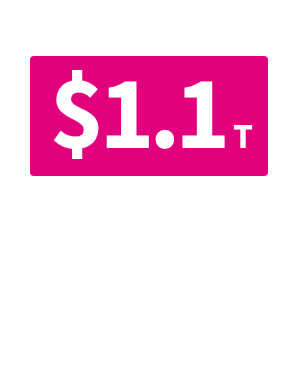Which states contribute the most and least to federal revenue?
In 2024, Californians paid about $275.6 billion more to the federal government than they received.
In FY 2024, the federal government collected around $5.07 trillion from states and their residents through taxes on individuals and businesses and redistributed about $4.87 trillion back to states and residents through programs like Social Security, Medicaid, Medicare, food stamps, and education grants.
The balance varies by state: Californians paid about $275.6 billion more to the federal government than they received, while Virginians received about $89.0 billion more than they paid.
Nineteen states sent more to the federal government than they received in FY 2024.
Balance of funds between residents and the federal government, FY 2024
That amounts to a differential of $216.0 billion, or about $635 per person, in favor of the federal government. It’s a relatively small amount at the national level, but a different picture at the state level, where some states contribute or receive much more than others.
How do states and individuals generate revenue for the federal government?
In short, taxes. In FY 2024, 87% of tax revenues came from individual income and payroll taxes. Another 11% came from business income taxes and the rest from estate, excise, and gift taxes.
Which states generate the most and least revenue for the federal government?
Of the $5.07 trillion in revenue from the states in FY 2024, 38% came from the nation’s four most populous states: California (15.9% of the total), Texas (8.2%), New York (7.6%), and Florida (6.4%). On average, states contributed almost $15,000 per resident to federal coffers.
Some less-populated states generated more than their populations would suggest. Massachusetts sent $21,933 per person to the federal government. Nebraska followed with $21,922, then Minnesota with $21,106. Washington, DC, sent $64,427, nearly triple the amount of the highest-paying state.
Massachusetts sent the most per person to the federal government in FY 2024.
Attributable per-capita revenue collected by the federal government by state
Massachusetts, Minnesota, and Washington, DC, generated individual income and payroll taxes for the federal government at a higher amount than the US average. For example, over $51,000 per capita was generated from income and payroll tax in Washington, DC, which was 5.2 times greater than the US average. In Nebraska, over $10,000 of per resident federal revenue came from business taxes, 6.1 times higher than the US average.
The federal government collected the least revenue per person from West Virginia ($4,912), Mississippi ($5,161), and New Mexico ($6,033).
How does government revenue get distributed to states and local communities?
Federal revenues are redistributed to states and the people living in them in many ways, some more direct than others.
Out of the $6.8 trillion overall spent by the federal government in 2024, $1.1 trillion went to states and local governments to support Medicaid and CHIP ($638 billion), food stamps ($51.1 billion), transportation ($95.5 billion), and education ($65.2 billion).
Another portion was dispersed directly to individuals, through programs like Social Security ($1.5 trillion) and veterans’ pension and disability ($162 billion).
Still more went to businesses via government contracts, schools and colleges for programs including Pell Grants and Head Start, and other nonprofits and institutions.
While food stamps, for instance, may be a more direct form of investment in a population than, say, business contracting, this analysis includes a broad variety of attributable spending to provide as comprehensive a view as possible.

Which states receive the most and least from the federal government?
The most populous states generate a big chunk of federal revenue and get the most back. Thirty-one percent of federal money disbursed to states and their residents in 2024 went to the four most populous states: California (10.9% of all disbursements), Texas (7.2%), Florida (6.5%), and New York (6.3%).
Controlling for population, Alaska and its residents received the most money per person, at $24,796, about a quarter of which came from funding agreements between the Indian Health Service and tribes in the state. Alaska was followed by Virginia ($23,975 per person) and New Mexico ($21,481). Washington, DC, again posts higher numbers than any state, getting $89,680 per person. About 30% of this came from contracts and grants from the Department of Transportation — including Amtrak funding — and Department of Defense funding for the military branches operating in the district.
Alaska received the most per person from the federal government in FY 2024.
Per-capita obligations made by the federal government by state, FY 2024
Which states send more to the federal government than they receive?
In terms of net contributions, 19 states sent more to the federal government than they received in 2024. The largest gaps were in California ($275.6 billion), New York ($76.5 billion), and Texas ($68.1 billion).
On a per-person basis, Nebraska ($9,531), Minnesota ($8,702), and Washington State ($7,139) contributed the highest net total.
How much do states send to the federal government vs. receive per person?
Balance of funds between residents and the federal government, FY 2024
Which states receive more from the federal government than they send?
The other 31 states and Washington, DC, received more than they sent, with the largest gaps in Virginia ($89.0 billion), Alabama ($44.7 billion), and South Carolina ($38.9 billion).
The largest per-person gap was in Washington, DC, where federal obligations outnumbered contributions by $25,254 per resident. New Mexico ($15,448), Alaska ($14,965), and West Virginia ($12,660) had the biggest gaps among states.
Dig into more data on how much the government contributes to each US state, how much the government spends, and get data delivered to your inbox weekly by signing up for our newsletter.

